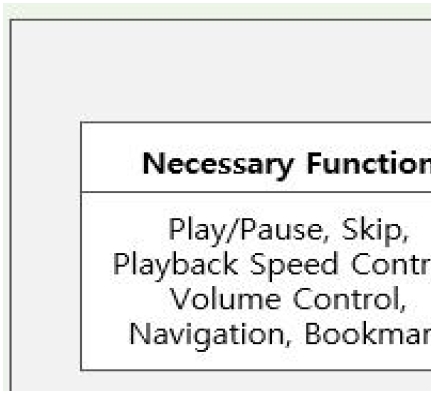
Guidelines of Designing DAISY Reading Assistive Devices for Koreans with Visual Disabilities
Copyright ⓒ 2018 The Digital Contents Society
This is an Open Access article distributed under the terms of the Creative Commons Attribution Non-CommercialLicense(http://creativecommons.org/licenses/by-nc/3.0/) which permits unrestricted non-commercial use, distribution, and reproduction in any medium, provided the original work is properly cited.

Abstract
The purpose of this study was to provide guidelines for the design of DAISY reading assistive devices for people with visual disabilities. To do this, we analyzed the existing DAISY player devices and viewer software and analyzed the literature on the needs of the visually impaired. Based on the results of the analysis, the DAISY player devices should be developed with playback essential functions, low cost, lightweight, easy to carry and easy operation for beginners and the elderly. PC and mobile-based DAISY viewer software should be developed for the advanced users of digital devices with the playback essential functions, add-ons, and screen interface configuration functions. As a result, specific design elements required for both types of DAISY players were presented as modules.
초록
이 연구의 목적은 시각장애인을 위한 데이지 독서보조기기 설계를 위한 가이드라인을 제시하기 위한 것이다. 이를 위해 기존 데이지플레이어기기 및 뷰어소프트웨어를 분석한 결과와 시각장애인의 요구에 대한 문헌을 분석하였다. 분석 결과를 토대로, 데이지플레이어기기에서 필요한 사항에는 초보자와 노인을 위한 재생 필수 기능, 저렴한 비용, 가볍고 간편한 휴대, 쉬운 조작이 포함되었다. PC 및 모바일 기반 데이지뷰어소프트웨어는 디지털기기에 익숙한 사용자를 위해 재생 필수 기능과 애드온 및 화면 인터페이스 구성 기능으로 개발해야 하는 것으로 나타났다. 결과적으로 두 종류의 데이지플레이어에 필요한 설계 요소를 모듈로 제시하였다.
Keywords:
Assistive Technology, DAISY, Information Accessibility, Print Disability, Reading Disability키워드:
보조공학, 읽기장애, 독서장애, 정보접근, 데이지1. Introduction
The number of Koreans registered as disabled is 2,545,637 by 2017[1]. Those with severe and visual disabilities registered as first and second grades are 38,380 among the 252,632 Koreans with visual disabilities. They rely on Braille and speech generating systems when reading books and information. The National Information Society Agency (NIA) supported information access assistive devices for these people[2], [3]. Between 2003 and 2015, NIA supported 8,317 screen reading software such as Sense Reader and Sense One, and 1,280 Braille information devices, Hansone. Between 2006 and 2015, the agency supported 5,739 voice readers including 3STAR and Blaze 2 OCR ET. The Korea Employment Agency for the Disabled (KEAD) also supported information access assistive devices for people with severe and visual disabilities[2], [4]. KEAD supported 1,153 voice reading software and hardware such as Sense Reader, Korean JAWS Professional, 3STAR, Blaze 2 OCR EZ, and VoiceEye PC-mate between 2012 and 2015. The agency also supported 674 Braille information devices including Hansone and SEIKA mini, 1,054 document recognition software and hardware such as Canon Lide 120, Sense One and Sorian, and 218 Braille printers such as M Print Spot Dot, BASIC-D, Braille Labeler, Everest-D, Columbia, and Tiger Premier 100.
However, people with visual disabilities criticized that the supported technology was often difficult to use[2], [5], [6]. DAISY (Digital, Accessible, Information, and SYstem) reading assistive devices, especially, tended to become complicated for advanced users and stopped distributing simple versions for beginners and the elderly. DAISY is a combination word of the first letters of Digital, Accessible, Information, and SYstem. “DAISY digital book format is designed to be a complete audio substitute for print material and is specifically designed for use by people with print disabilities, including blindness, impaired vision, and dyslexia. Based on the MP3 and XML formats, the DAISY format has advanced navigation features in addition to those of a traditional audio book.”[7]. In this study, DAISY reading assistive devices are divided into DAISY player devices and PC and mobile based DAISY viewer software.
The purpose of the study was to propose guidelines of designing DAISY reading assistive devices for people with visual disabilities. To do so, existing DAISY reading assistive devices and the needs of the users in the literature were reviewed.
2. DAISY Player Devices
Blaze 2 OCR EZ and Linio Pocket distributed in Korea and Victor Reader Stream and Book Port Plus used abroad were analyzed[2].
2.1 DAISY Player Device Features
The Blaze 2 OCR EZ was operated with simple steps, but there was no keypad unlike the previous version. The OCR function was not stable, and the performance was low. The Linio Pocket produced in Japan and used in Korea by Korean language. It supported a cappella software to provide a good sound and playback experience. It could download files in real time via wireless internet and had automatic volume control function.
Both DAISY player devices had playback functions of play/pause, skip, speed, and volume. Navigation by various units such as page, section, and phrase was provided within contents. Their functions were added every time new versions were released. DAISY player devices became complicated to use and expensive.
Victor Reader Stream supported digital talking books downloaded from NLS, BookShare, Ally, etc. through the DAISY library. A capella software provided good quality voice features and an easy interface with a tactile keypad. It was possible to download contents directly by wireless internet, and voice acceleration control was excellent. The battery lasted for 15 hours. Book Port Plus supported digital talking books from NLS and BookShare and offered good quality recording. Nevertheless, it was inconvenient to use because of many buttons with similar shapes. Playback-related functions included play/pause, skip, playback speed, and volume control. The navigation function was provided in pages, sections, and phrases. Bookmark insertion, deletion, shortcut, and preview functions were provided.
2.2 Users’Needs
The beginners and the elderly with severe and visual disabilities using Korean DAISY player devices said that the devices were complicated to use, had too many functions than they needed, and were too expensive to afford personally[2], [6]. The blind people preferred DAISY player devices with a few buttons and simple operation[6]. Those over 60 of age with visual disabilities answered that Daisy player devices were difficult and complicated[6]. They could not use most of the features including various functions in one button. They asked for voice guidance to learn and use the devices without an earphone. The maximum volume in the devices was not loud enough.
3. DAISY Viewer Software
3.1 PC DAISY Viewer Software Features
AMIS, Bookshare Web Reader, DAISY player by Jos Lermmens, Doria DAISY Reader for Windows, KBLL Reader, and Kolibre KADOS & Kolibre Vadelma, introduced in DAISY Consortium were analyzed[2]. AMIS was an open source DAISY play software developed by DAISY Consortium. AMIS could be operated with simple usage shortcuts (keyboard left, right, space). It had the advantage of reading a menu by placing a mouse on it, and provided a dual interface. BookShare Web Reader was a Web reader using a web browser and provided the most basic functions for reading. The DAISY player by Jos Lermmens was a DAISY CD player for Linux that supported about 40 file formats besides DAISY 2.02 & 3 version format. Doria DAISY Reader for Windows was a DAISY 3.0 digital book reader that supported three languages: Portuguese, English and Spanish. It offered a dual interface and displayed the screen using three colors (black, white, and yellow). The KBLL Reader was developed by the Korea Braille Library and provided various ways to navigate by document structure. It was currently registered on the DAISY Consortium website but rarely used. KADOS stood for Kolibre Adaptive DAISY Online Service. It supported DAISY Online Transfer Protocol version 1.0. It was implemented in Linux environment and had no visual interface. Vadelma was a player implementing the KADOS service on the Raspberry Pie platform, also known as the Linux Talking Book player. It supported DAISY 2.02 & 3 and operated with 14 numeric keypads. This also had no visual interface.
Some of the software had playback, navigation, bookmark, player information, note, or search functions. It was difficult for beginners to operate the shortcut keys and to find a bookmark after putting it in the viewer software. None of the software had all of its core functions. DAISY viewer software for PC in Korean version was not available[2].
3.2 Mobile Based DAISY Viewer Software Features
Mobile application based DAISY viewer software for people with visual disabilities in Korea was Lux DAISY, The World’s First Ubiquitous Library, and DREAM[2]. The Lux DAISY was a DAISY book reader application[2]. Key features included reading function and main functions with gesture for users who were uncomfortable with touch operation. Zip-compressed books were provided. DAISY books stored in a specific folder could be collectively registered and utilized.
The World’s First Ubiquitous Library was an application that supported both text and DAISY books and provided services using the Android Talkback function. The authorized users only could use the service through the confirmation of the welfare card for the disabled, and they could receive all the services of the library free of charge. In addition to general books, it also provided various voice DAISY contents such as movie scenarios, classical lectures, and recorded books.
The DREAM provided a feature to read books in a cloud-based alternative mobile service. Users could search for a list of alternative materials produced by the library in cooperation with the National Library for the Disabled, and use textual DAISY, audio DAISY, and MP3 recording material services.
Three of them had playback and bookmark functions. However, voice DAISY help or player information was not provided. Overall, each mobile based DAISY viewer software had limited access to DAISY contents because they were developed in different institutions and not networked across the country. The existing mobile based DAISY viewer software in Korea lacked viewer interface functions such as screen mode, day/night mode, or custom mode for those with low vision. People with low vision were not easily accessible to screen menus on DAISY viewer software because they could not adjust the interface of screen menus for their needs.
3.3 Users’Needs
The group of people with low vision preferred to use mobile based DAISY viewer software and asked for a button type input/output auxiliary device which was easy to operate the application because the button was more familiar than the screen touch type operation[6]. The blind users of Korean DAISY viewer software on mobile devices said that the voice guidance was not easy to use. The on-screen keypad was difficult to operate for those with low vision[6]. They had difficulty in operating a menu button with two or more different functions, using shortcuts, and finding a bookmark after putting it.
4. Guidelines of DAISY development
The group of people who needed a simple DAISY player device tended to read novels, newspapers, and religious books[6]. The other was the people who used smart phones and PCs actively and would read professional materials and articles with writing and inputting tasks such as emailing, homework and job duties[6].
A DAISY player device should be easy to use, lightweight, and portable, incorporating playback related core functions. Mobile based DAISY viewer software should perform various functions and provide screen interface adjustment functions for people with low vision. Users should have more opportunities to learn how to use these devices and software, and DAISY contents should be greatly more produced[6]. PC DAISY viewer software practically did not exist in Korean. So, it should be developed for various options for those with visual disabilities .
The functional requirements of a DAISY player device were simple use with essential features, low cost, and lightweight and portable. Both PC and mobile based DAISY viewer software should be developed with playback essential functions and add-ons and screen interface configuration functions. All groups of the users with visual disabilities responded that the essential features of DAISY players were play back functions with play/pause, skip, play speed, and volume control, navigation of page, section, and phrase, bookmark, additional information such as DAISY help and player information, Search, and other functions of timer, recording, and wireless internet[6]. The development guidelines for the two types were described as the following.
4.1 Guidelines of Designing DAISY Player Device
A DAISY player device suggested in the study had hardware with motherboard, operating system, and networks, and software with necessary functions, additional functions, control functions, and DAISY ebook processing technology as shown in Fig. 1. The motherboard needed SBC reference-based motherboard, RAM with at least 4GB internal memory, ports, storage, GPIO, and CPU. The operating system should have embedded Linux, Windows 10-based, and Android-based operating system. The networks had 10/100 ethernet and 2.4GHz 802.11n network module and bluetooth with Bluetooth 4.1 Classic and BLE (Bluetooth low energy).
The necessary functions in software had play/pause, skip, playback speed control, volume control, navigation, and bookmark. The additional functions were additional information (DAISY help, device information), timer, recording, wireless internet, and screen interface settings. The control functions had operation functions of next, previous, and select. The DAISY ebook processing technology was various types of ebook TTS interworking function.
4.2 Guidelines of Designing PC and Mobile Based DAISY Viewer Software
The guidelines of designing PC and mobile based DAISY viewer software were suggested as presented in Fig. 2. The DAISY viewer software was consisted of necessary functions, additional functions, control functions, viewer interface functions, DAISY ebook processing technology, and I/O auxiliary device interface.
The viewer interface functions were by screen display rendering engine and font size, font color, font style, high contrast screen, zoom functions, etc. The DAISY e-book processing technology had various types of e-book TTS interworking function. The I/O auxiliary device interface included DAISY viewer software and auxiliary equipment interworking module and I/O auxiliary device operation interface.
4.3 Guidelines of Designing I/O Auxiliary Equipment Development
The I/O auxiliary equipment should have basic operation keys and interlocking function. The basic operation keys were selection keys for up, down, left, and right. The interlocking function was interoperability with Android and iOS via bluetooth.
5. Conclusion
The development guidelines for a DAISY player device and PC and mobile based DAISY viewer software were presented. The existing DAISY player devices and PC and mobile based viewer software used in Korea and previous literature on the needs of the people who had used DAISY players were analyzed. The study identified two groups of those who needed simple and essential functions with tactile buttons and others who needed various functions and screen interface configuration on PCs and mobile devices with an I/O auxiliary equipment.
These devices and software should be developed as suggested in the future study for those with visual disabilities who have difficulty in using the present DAISY reading hardware and software and speech generating systems[8]. With the new device and software, the education and information of how to use DAISY players should be provided in person and in a voice format with the devices. The DAISY contents also should be produced as printed materials are published constantly.
Acknowledgments
This research was supported by the National Research Foundation of Korea (NRF) funded by the MSIT (NRF-2018R1A4A1025559) in 2018 and the National Library for the Disabled in 2016 (A study on the validity of development for reading auxiliary equipment based on the DAISY books).
References
- Ministry of Health and Welfare Homepage, (2018, November), Disability Statistics [Online], http://www.mohw.go.kr/react/jb/sjb1101ls.jsp?PAR_MENU_ID=03&MENU_ID=03320101.
- S-B. Lim, J-W. Lee, and J. Yook, A Study on the Validity of Development for Reading Assistive Device Based on the DAISY Books, Seoul, Korea, National Library for the Blind, (2016).
- Korea Agency of Digital Opportunity & Promotion Homepage, Information access assistive devices supported. National Information Society Agency (NIA) [Internet], Available: http://www.at4u.or.kr/index.asp.
- Korea Employment Agency for the Disabled (KEAD) Homepage, Assistive technology devices supported [Internet], Available: https://www.kead.or.kr/view/service/service04_11_01.jsp?sub1=14&sub2=4.
- National Library for the Disabled, Survey on the Actual Condition of Reading Activity for the Disabled, Seoul, Korea, National Library of Korea, (2016).
-
J-H. Park, S-B. Lim, J. Yook, and J-W. Lee, “An Analysis on the Disability Types and Requirements for Developing DAISY Reading Assistive Devices”, The Journal of Special Education & Rehabilitation Science, 56(3), p503-520, September), (2017.
[https://doi.org/10.23944/jsers.2017.09.56.3.21]

- DAISY Consortium, Glossary, Available: http://www.daisy.org/glossary#letter_d.
- S-B. Lim, J-H. Park, J-W. Lee, and J. Yook, “A Study on the Economic Feasibility of Developing Daisy Book Based Reading Assistive Devices for People with Disabilities”, The Journal of Rehabilitation Welfare Engineering & Assistive Technology, 11(4), p279-285, November), (2017.
저자소개

1991 : Dept. of Special Education, Dankook University, B.A.
1995 : Dept. of Special Education, University of South Carolina, M.Ed.
2000 : Dept. of Special Education, University of South Carolina, Ph.D.
2000~2004 : Korea Employment Agency for the Disabled, Researcher
2004~present : Korea Nazarene University, Professor
2013~2014 : California State University at Northridge, Visiting Scholar
※ Research Area: Special Education Technology, Assistive Technology, ICT Accessibility, Multimedia Contents for the disabled and the elderly

2010. : Dept. of Multimedia Science, Sookmyung Women’s University, B.S.
2012 : Dept. of Multimedia Science, Sookmyung Women’s University, M.S.
2013~present: Dept. of IT Engineering, Sookmyung Women’s University, Ph.D. Candidate
※ Research Area: Multi-modal User Interface, UI/UX, Accessibility, UI for disabled People, HCI, Web and Mobile Multimedia Contents

1982 : Dept. of Computational Statistics, Seoul National University, B.S.
1983 : Dept. of Computer Science, Korea Advanced Institute of Science and Technology, M.S.
1992 : Dept. of Computer Science, Korea Advanced Institute of Science and Technology, Ph.D.
1989~1992 : Human Computer, Inc., Research Director
1992~1997 : Sambo Computer, Inc., Engineering Director
1997~2001 : Konkuk University, Assistant Professor
2001~present : Sookmyung Women's University, Professor
2016 : University of Colorado, Visiting Professor
※ Research Area: Web and Mobile Multimedia Contents, User Interface, Electronic Publishing, eBook, XML Documents

1990 : Dept. of Computer Engineering, Seoul National University, B.S.
1992. : Dept. of Computer Engineering, Seoul National University, M.S.
1996 : Dept. of Computer Engineering, Seoul National University, Ph.D.
1994~1999 : Hyundai Electronics Industries, Co., Hyundai Information Technologies, Co.
1999~2002 : Hallym University at Chooncheon, Assistant Professor
2002~2003 : Kwangwoon University at Seoul, Assistant Professor
2003~2004 : INIXSOFT, Co., CTO
2004~present : Sookmyung Women's University, Professor
2008 : State University of New York at Stony Brook, Research Scholar
2012~2018 : NAVER Corporation, Outside Director
2015 : University of New York, Visiting Professor
2015~present : KIISE Transactions on Computing Practices, Chief Editor
※ Research Area:System Software, Parallel and Distributed Systems, Operating Systems, Computational Finance


